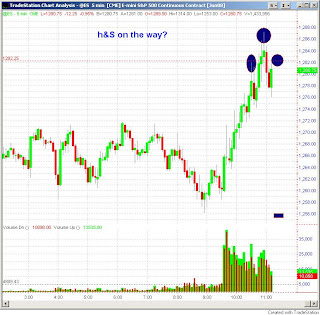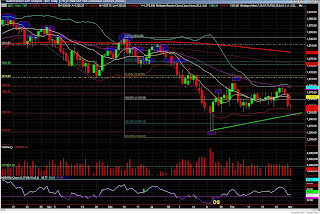Treasuries rose a second straight day as U.S. durable goods orders unexpectedly fell last month and home sales dropped, adding to concern that the economy is in a recession. Government debt rallied even as the Treasury prepares to sell $28 billion in two-year notes today, the most since 1972.
Purchases of new homes slowed to a 590,000 annual pace last month, the lowest level in 13 years, from 601,000 in January, according to the Commerce Department. Wall Street banks, brokerages and hedge funds may report $460 billion in credit losses from the collapse of the subprime- mortgage market, or almost four times the amount already disclosed.
Appetite may wane at the two-year note auction today amid a decrease in bets for Fed rate cuts. Traders see a 40 percent chance the Fed will cut its target rate a half percentage-point to 1.75 percent at its next meeting on April 30, compared with 82 percent a week ago, according to futures contracts on the Chicago Board of Trade. The rest of the bets are on a quarter- point reduction.
Wednesday, March 26, 2008
Tuesday, March 25, 2008
Merrill Lynch says let em go
Layoffs at Merrill have been a long time coming. Now they’re right around the corner. In the next several weeks, the nation's biggest brokerage will quietly begin a big round of layoffs as it looks to cut costs and shore up profits as the credit crunch deepens, sources tell Trader Monthly. Merrill officials are drawing up plans to cut 10 percent to 15 percent from the investment banking division, sources familiar with the plans said. That could put as many as 300 Merrill bankers out on the pavement. (Merrill employs about 2,100 bankers firmwide.) Meanwhile, the firm is also preparing for another big writedown. Although the exact size and timing is unclear, some people familiar with the situation say it could be as high as $8 billion.
Saturday, March 22, 2008
$75 billion in treasuries next week, any buyers?
In a sign investors' loss of confidence in credit markets is deepening, rates on three-month Treasury bills fell to the lowest level since 1954. The Fed will auction $75 billion in Treasuries next week in exchange for an expanded array of collateral to ease the logjam in lending. Treasury prices are at unsustainable levels and we've completely backed away from the market.
Fed policy makers on March 18 cut their target lending rate by three-quarters of a percentage point to 2.25 percent, saying ``measures of inflation expectations have risen.'' The cut was smaller than the 1 percentage point traders had expected with 90 percent certainty before the meeting.
This week, a solid majority of panelists believe mortgage rates will rise over the next 35 to 45 days. About one-quarter think rates will fall, and the rest believe rates will remain relatively unchanged (plus or minus 2 basis points).
Fed policy makers on March 18 cut their target lending rate by three-quarters of a percentage point to 2.25 percent, saying ``measures of inflation expectations have risen.'' The cut was smaller than the 1 percentage point traders had expected with 90 percent certainty before the meeting.
This week, a solid majority of panelists believe mortgage rates will rise over the next 35 to 45 days. About one-quarter think rates will fall, and the rest believe rates will remain relatively unchanged (plus or minus 2 basis points).
Wednesday, March 19, 2008
Treasury notes and Elevated inflation
Treasury 10-year notes rose, erasing half of yesterday's losses, on speculation the Federal Reserve will be less aggressive in cutting interest rates and focus on inflation. The difference in yields between two- and 10-year notes narrowed for a third day as traders pared bets the Fed will reduce the target lending rate by a half-percentage point at its April 30 meeting. Policy makers cut borrowing costs less than expected yesterday, saying inflation remained ``elevated.''
Futures on the Chicago Board of Trade show 70 percent odds the Fed will cut the 2.25 percent lending target by a half- percentage point at its meeting on April 30, compared with an 88 percent chance yesterday. The rest of the bets are for a quarter-point reduction.
Gold, used to hedge against rising prices, plunged the most since June 2006, falling 4.1 percent on the New York Mercantile Exchange. Crude oil for April delivery fell $2.04, or 1.9 percent, to $107.38 a barrel. Treasuries tumbled yesterday, pushing up two-year note yields by the most since 2001, after the Fed cut the target lending rate by three-quarters of a percentage point to 2.25 percent and said measures of inflation are ``elevated.''
Futures on the Chicago Board of Trade show 70 percent odds the Fed will cut the 2.25 percent lending target by a half- percentage point at its meeting on April 30, compared with an 88 percent chance yesterday. The rest of the bets are for a quarter-point reduction.
Gold, used to hedge against rising prices, plunged the most since June 2006, falling 4.1 percent on the New York Mercantile Exchange. Crude oil for April delivery fell $2.04, or 1.9 percent, to $107.38 a barrel. Treasuries tumbled yesterday, pushing up two-year note yields by the most since 2001, after the Fed cut the target lending rate by three-quarters of a percentage point to 2.25 percent and said measures of inflation are ``elevated.''
SP 500 daily March 19
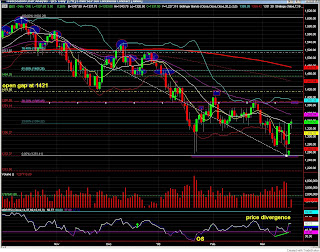
After the Fed. Market has been hit with Hammer of money.
Oil will fall a bit, gold will retrace down and we will consolidate here while the bear re assess where the next financial crisis will occur.
Bank One, Discover, and American Express are writing off debt at a faster rate than ever before. Consumer credit is going to take it on the head.
Tuesday, March 18, 2008
Pre Fed Gap up 20 points
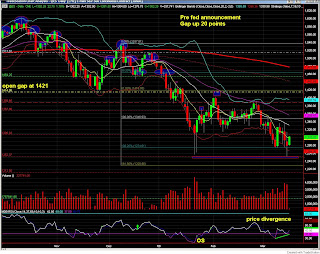
Well we have a 20 point gap up before the open. Fed meeting at 2:00.
The roller coaster will be leaving the station soon.
We have had some prettty large volume going through these past days and today could be the same.
We have some price divergence on the RSI.
Close the gap, rally big off the rate cut news and wathc the US currency dive.
Monday, March 17, 2008
Lehmans next with $5 a gallon soon
Well Bear Stearns was saved, Lehmans lost 25% of their value in one day and gasoline could be $5.00 a gallon before labor day.
Seems like this could be a long hot summer.
Some are calling this a bottom. Looks to me like we have been thrown a rope, to hang on to be hanged on. We shall see
Seems like this could be a long hot summer.
Some are calling this a bottom. Looks to me like we have been thrown a rope, to hang on to be hanged on. We shall see
Gold hit $1,033, Oil $112 Dollar dives
The Fed announced two initiatives designed to bolster market liquidity and promote orderly market functioning, and approved the JP Morgan - Bear Stearns deal. First, they authorized the Federal Reserve Bank of New York to create a lending facility to improve the ability of primary dealers to provide financing to participants in securitization markets.
It is available today, and will be in place for at least six months and may be extended as conditions warrant. Credit extended to primary dealers under this facility may be collateralized by a broad range of investment-grade debt securities.
Second, the Federal Reserve Board decreased the primary credit rate ("Discount Rate") from 3.5% to 3.25%. Lastly, the Board also approved the financing arrangement announced by JPMorgan Chase and Bear Stearns where Bear is being purchased for 1% of its value only 16 days ago! Tomorrow, the FOMC will meet, and obviously the odds that the Fed will cut the Fed Funds rate by 1.0% have increased. Mortgage prices are really a mixed bag ("where should they be priced?") with the 10-yr down to 3.41% currently.
It is available today, and will be in place for at least six months and may be extended as conditions warrant. Credit extended to primary dealers under this facility may be collateralized by a broad range of investment-grade debt securities.
Second, the Federal Reserve Board decreased the primary credit rate ("Discount Rate") from 3.5% to 3.25%. Lastly, the Board also approved the financing arrangement announced by JPMorgan Chase and Bear Stearns where Bear is being purchased for 1% of its value only 16 days ago! Tomorrow, the FOMC will meet, and obviously the odds that the Fed will cut the Fed Funds rate by 1.0% have increased. Mortgage prices are really a mixed bag ("where should they be priced?") with the 10-yr down to 3.41% currently.
Sunday, March 16, 2008
Daily SP 500 March 16 after Fed
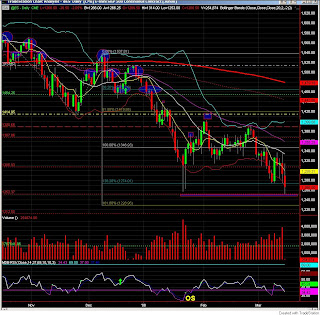
Watch out, today could be the next Black Monday.
This has some support but would it hold. Heard a very interesting conversation that Since the Fed has made funds available to the trading houses that they are shorting their own stocks.
Good to know they can borrow the money to short their own stocks considering how poorly they are doing with the Sub prime.
Crash Levels
Well if JP Morgan picks up Bear Stearns for $2 a share there will be a few rather pissed off billionaires who have just lost a couple hundred billion dollars.
I am expecting crash levels of:
1249
1212.50
1182.50
This is quite a volital time, be prepared to see big swings on News.
Trade what you see.
I am expecting crash levels of:
1249
1212.50
1182.50
This is quite a volital time, be prepared to see big swings on News.
Trade what you see.
Friday, March 14, 2008
Please save our company Mr. Bernanke, Please
Monday I expect to see the market plummet.
U.S. stocks plunged for a third day, the dollar sank to the weakest level ever against the euro and to a 12-year low versus the yen and gold surged to a record $1,009 an ounce. Crude oil for April delivery fell after touching $111 a barrel yesterday, the highest since trading began in 1983. As mentioned earlier.....inflation, inflation, inflation.
JPMorgan Chase and the New York Fed agreed to provide funding to Bear Stearns as the securities firm said its cash position has ``significantly deteriorated.'' Bear said it was in talks with New York-based JPMorgan Chase ``regarding permanent funding or other alternatives.'' The Fed agreed to provide financing through JPMorgan for up to 28 days. A collapse of Bear Stearns would be the biggest failure of a U.S. financial institution since the insolvency of Continental Illinois National Bank and Trust Co. in 1984. LET EM GO! get a correction in here and lets end this pain.
Falling property values has made it difficult for homeowners to refinance even as Fed policy makers slashed the target rate for overnight bank lending by 2.25 percentage points since September to stimulate economic growth and bank lending. Expect the criteria for underwriting to be severe. Bye bye to stated loans.
U.S. stocks plunged for a third day, the dollar sank to the weakest level ever against the euro and to a 12-year low versus the yen and gold surged to a record $1,009 an ounce. Crude oil for April delivery fell after touching $111 a barrel yesterday, the highest since trading began in 1983. As mentioned earlier.....inflation, inflation, inflation.
JPMorgan Chase and the New York Fed agreed to provide funding to Bear Stearns as the securities firm said its cash position has ``significantly deteriorated.'' Bear said it was in talks with New York-based JPMorgan Chase ``regarding permanent funding or other alternatives.'' The Fed agreed to provide financing through JPMorgan for up to 28 days. A collapse of Bear Stearns would be the biggest failure of a U.S. financial institution since the insolvency of Continental Illinois National Bank and Trust Co. in 1984. LET EM GO! get a correction in here and lets end this pain.
Falling property values has made it difficult for homeowners to refinance even as Fed policy makers slashed the target rate for overnight bank lending by 2.25 percentage points since September to stimulate economic growth and bank lending. Expect the criteria for underwriting to be severe. Bye bye to stated loans.
Monday, March 10, 2008
When will rates get better? S&P 500 is starting to fall.

Looking back to Friday, we had a nice improvement in both Treasury rates and mortgage prices after the payroll numbers indicated that labor is indeed slowing. The market believes that the Fed will lower overnight interest rates by 75 bps at the FOMC meeting next Tuesday, and some think that Fed Funds may eventually hit 2.0%. Friday's job report had very little "good" news for the economy, as NonFarm payrolls dropped for the second consecutive month, with back-month revisions downward, and most industries showed job losses.
This week we'll see the US trade deficit report tomorrow (expected -$59 billion), Thursday's weekly jobless claims (expected +4k to 355k), February Retail Sales (expected +0.8%), and then on Friday the Consumer Price Index for February (expected +0.3%) and the University of Michigan's Consumer Confidence report (expected -0.4). Currently the 10-yr is at 3.53% and mortgages are roughly unchanged from Friday.
So here's the $100 million question.... When the heck are mortgage prices going to improve? Why is the 10-yr Treasury down into the 3.5% range, yet conforming/conventional 30-yr loans, eligible for FNMA & FHLMC, back up into the 6% range? The widening that is occurring out to these levels, which statistically speaking happens once every 4,000 years, is a combination of several factors.
First, investors and money managers feel safer putting their money into Treasury securities rather than mortgage-related securities (right now, that seems like a "no brainer") Subjecting their money to the potential of borrowers defaulting and property depreciation is something that many prefer not to do. These two factors have led to losses for FNMA & FHLMC, along with others, and some investors have been selling mortgage securities in order to meet capital requirements. And selling has led to lower prices, and thus higher rates. That's it in a nut shell.
This week we'll see the US trade deficit report tomorrow (expected -$59 billion), Thursday's weekly jobless claims (expected +4k to 355k), February Retail Sales (expected +0.8%), and then on Friday the Consumer Price Index for February (expected +0.3%) and the University of Michigan's Consumer Confidence report (expected -0.4). Currently the 10-yr is at 3.53% and mortgages are roughly unchanged from Friday.
So here's the $100 million question.... When the heck are mortgage prices going to improve? Why is the 10-yr Treasury down into the 3.5% range, yet conforming/conventional 30-yr loans, eligible for FNMA & FHLMC, back up into the 6% range? The widening that is occurring out to these levels, which statistically speaking happens once every 4,000 years, is a combination of several factors.
First, investors and money managers feel safer putting their money into Treasury securities rather than mortgage-related securities (right now, that seems like a "no brainer") Subjecting their money to the potential of borrowers defaulting and property depreciation is something that many prefer not to do. These two factors have led to losses for FNMA & FHLMC, along with others, and some investors have been selling mortgage securities in order to meet capital requirements. And selling has led to lower prices, and thus higher rates. That's it in a nut shell.
Tuesday, March 4, 2008
Treasuries were little changed with two-year note yields near the lowest in almost four years deterring investors and Federal Reserve officials indicating the U.S. economy remains under pressure from the housing slowdown, credit debt, bonds and bond insurers.
Fed Chairman Ben S. Bernanke urged lenders to forgive portions of mortgages for more borrowers whose home values have declined, and Vice Chairman Donald Kohn said U.S. banks face ``challenging market conditions.'' Bernanke, in remarks at a conference in Orlando, Florida, said more must be done to stem foreclosures. ``Efforts by both government and private-sector entities to reduce unnecessary foreclosures are helping, but more can, and should, be done,'' he said. ``Principal reductions that restore some equity for the homeowner may be a relatively more effective means of avoiding delinquency and foreclosure.''
In a sign the U.S. economic slowdown is spreading, the Bank of Canada cut its benchmark lending rate by a half-percentage point and signaled it will have to act again to offset a slump in exports to the U.S. The slowdown in the U.S. is beginning to have a greater effect on the rest of the world. Citigroup Inc., the biggest U.S. bank, may need additional capital from outside investors as losses stemming from the collapse of the U.S. subprime mortgage market increase.
First it will hit America/Canada, next will be Britan then Europe. Expect to see new high against the dollar across the board.
$4.20 a gallon gas could be coming for this summer.
We shall see.
Fed Chairman Ben S. Bernanke urged lenders to forgive portions of mortgages for more borrowers whose home values have declined, and Vice Chairman Donald Kohn said U.S. banks face ``challenging market conditions.'' Bernanke, in remarks at a conference in Orlando, Florida, said more must be done to stem foreclosures. ``Efforts by both government and private-sector entities to reduce unnecessary foreclosures are helping, but more can, and should, be done,'' he said. ``Principal reductions that restore some equity for the homeowner may be a relatively more effective means of avoiding delinquency and foreclosure.''
In a sign the U.S. economic slowdown is spreading, the Bank of Canada cut its benchmark lending rate by a half-percentage point and signaled it will have to act again to offset a slump in exports to the U.S. The slowdown in the U.S. is beginning to have a greater effect on the rest of the world. Citigroup Inc., the biggest U.S. bank, may need additional capital from outside investors as losses stemming from the collapse of the U.S. subprime mortgage market increase.
First it will hit America/Canada, next will be Britan then Europe. Expect to see new high against the dollar across the board.
$4.20 a gallon gas could be coming for this summer.
We shall see.
Monday, March 3, 2008
Treasuries fell, with the difference between the 10-year note's yield and the two-year rate increasing to near the widest in more than 3 1/2 years, on bets Federal Reserve interest-rate cuts will stoke inflation. Bonds slumped as oil traded above $100 a barrel and gold futures rose to a record high. Treasuries pared earlier gains as speculation eased that policy makers are considering a cut in the discount rate at a meeting of the board of governors today.
A posting on the Fed's Web site said that a board meeting today would include the ``review and determination by the board of governors of the advance and discount rates to be charged by Federal Reserve banks.''
The Fed's first interest-rate response to the August credit collapse was to lower the discount rate, rather than the benchmark federal funds rate target. The market is hyper-sensitive to anything the Fed does.
A posting on the Fed's Web site said that a board meeting today would include the ``review and determination by the board of governors of the advance and discount rates to be charged by Federal Reserve banks.''
The Fed's first interest-rate response to the August credit collapse was to lower the discount rate, rather than the benchmark federal funds rate target. The market is hyper-sensitive to anything the Fed does.
Subscribe to:
Posts (Atom)
